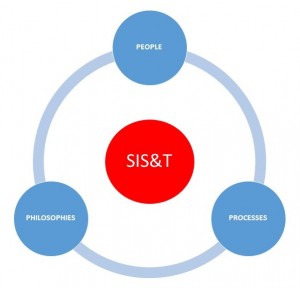Here are some technologies I think will become more integral parts of student affairs business in the next years – the internet of things, wearable computing, big data, analytics, social media, mobile, and cloud. Of course, some of these technologies are already in place. Still, the internet of things, big data, and wearable computing will become even more significant in how student affairs organizations do business and communicate with our students and customers. The future trend will evolve towards greater personalization in how information/services are delivered and what information is available based on context. Can you imagine the possibility I wrote about in this post? The changing student population (non-traditional, international, veterans, …), political pressures for accountability amid increasing tuition costs, and technological advancements are just a few variables that will shape the use of technology in student affairs.
While I can discuss the specific uses of the technologies I mentioned above, I’d like to focus more on the topics that we, as student affairs and IT professionals, must keep in mind as we consider using new technologies. This blog post will explore some of the challenges of using new technologies. It will also discuss some considerations regarding the effective use of technology in student affairs.
One of the challenges in predicting the future of anything is that does anyone know about the future? One can only look at potential scenarios based on history, current events, and factors (political, economic, social, technology, environment, legal – PESTEL) at different levels (local, national, global) and make some assumptions. In the world of student affairs and higher ed technology, another challenge is determining at what point to adopt new technologies as part of the way we do business. Of course, for the adoption of new technologies to happen at the institutional level, individuals who have the authority to allocate resources towards these efforts must be convinced that the benefits outweigh the risks and that these new technologies add value to the institution’s goals. In some cases, these individuals might not be motivated by institutional goals and risk/value analysis, but rather, the questions are more personal – “what’s in it for me?” and “does this add more work for me?”
Another topic central to the use of technology in student affairs is the concept of high touch/high tech in how we conduct our business, particularly in working with students. But technology cannot and should not replace all our interactions with our customers but rather complement them, as I discussed in this blog post.
I offered the challenges above because as we move to a likely scenario of what student affairs technology may look like, I think we can learn from past lessons. Consider the following responses I’ve received in my effort to introduce new technologies at my institution. These are sentiments from some of my IT colleagues and business users.
~1996 – “What do we need websites for? They’re fads. We have brochures.”
~2007 – “Social media? They’re fads. Security risks.”
~2009 – “Mobile? Students don’t use mobile. They’re fads. Security risks.”
~2012 – “Cloud? Our data center is more secure. They’re fads. Security risks.”
History shows that while platforms/tools within the technologies mentioned above may change (remember MySpace, Second Life), it seems these technologies will be around for a while and that they’ve become integral components in student affairs organizations. They’ve transformed how we do business. Here’s the reality: security risks are involved in making data available online, so as technology providers and end-users, this risk must always be considered. Furthermore, the use of technology introduces issues related to ethics and privacy. These must also be addressed.
As incorporating the internet of things and wearable computing into student affairs becomes a wider discussion, I suspect I will receive the same reactions as above – “They’re fads. Security risks. No one uses them. They’re toys.” The problem with that response is that rejecting the possibilities (maybe even inevitability) takes time to learn about these technologies and even longer to implement them. The design and approach to new systems must also change from an IT perspective. Consider the idea that user interfaces are no longer limited to screens but now include voice (aural) like Siri and Amazon Echo, gestures such as Leap Motion, wearable computing such as iWatch and Google Glass, and geo-location like iBeacons.
Even a more significant challenge is that there’s a mindset, practical skills, and knowledge within the organization that must evolve along with using these new technologies.
By the time our institutions come to the realization that they’re behind the realities of the needs and wants of their customers, we are now having to play catch up. We find ourselves in reactive vs. adaptive mode, which could lead to ineffective/costly implementations and, even worse, solutions that customers and end-users don’t find entirely usable. However, there’s also the danger of using new technologies for technology’s sake. Perhaps the most important aspect of how technology is used in student affairs should be why we are using it first. It is too easy to get caught up in the excitement of using new technologies because everyone is using them, or there’s the sense that we could get left behind. Finding the right time to adopt new technology in our organization is a difficult challenge. Perhaps, one way to approach the challenge above is to keep in mind the goals of student affairs, student learning, development, and success, when discussing technology implementation and use. As I wrote in this blog post, student affairs organizations and professionals must maintain the core mission and keep up with the trends.
This week, the proposed technology competencies were made available by NASPA/ACPA to the general public for feedback. That technology, previously a “thread” in the current list of competencies, is now a proposed competency is the right approach to addressing how technology fits into our student affairs roles as educators. The summary of the proposed technology competency, I think, effectively puts into context how technology can be used in student affairs. The proposed competencies are constructed at a level that can be used simultaneously and is not geared toward specific technologies.
“The educational technology competency area focuses on using digital tools, resources, and technologies for the advancement of student learning, development, and success as well as the improved performance of student affairs professionals. Included within this area are knowledge, skills, and dispositions that lead to the generation of digital literacy and digital citizenship within communities of students, student affairs professionals, and faculty members, and colleges and universities.”‘
The competencies and efforts ACPA’s Digital Task Force and NASPA’s Technology Knowledge Committee put forth ensure that technology use in student affairs is guided through the right frameworks.
For student affairs professionals to develop these competencies, organizations must commit to the culture of providing opportunities for staff (as well as students) to learn and practice them. This requires technology leadership at the senior student affairs officers’ table. These technology leaders must know/skills that include student affairs/higher ed history, theories, contemporary issues, and enterprise technology level implementations. Senior student affairs officers themselves must also accept the reality that they need to play the role of information technology managers.
Graduate programs must also play their part in educating future professionals about technology use in student affairs.
So, as we discuss the likely scenario of the future of student affairs technology, let’s keep in mind lessons learned from the past, keep our core missions as guiding principles, develop skills/knowledge as well as adopt an open-minded mentality that will allow us to adaptive and not reactive to be able to keep up with the dynamic needs of our ever-changing students we serve.
What’s your vision of the future of student affairs technology?
 As a leader of an organization and an advocate for students and staff alike, I have the responsibility to convey the concerns and issues facing my constituents to the campus at different levels of conversation. As part of the responsibility, I am always careful, though not always successful, in making sure I carry myself in a way that, even when I disagree with colleagues and those I deal with, my presence and what I share add value to the conversations. While I certainly play the role of agitator at times, I try to be respectful and carry myself in a way that others do want to engage me in conversations. Each interaction with another person is an opportunity to build relationships and trust, or it could just be when others decide they’d rather not deal with you because you’re perceived as a “smart jerk,” “know-it-all,” rude, or just simply too unreasonable. What good am I as an advocate for students, for my organization, and for myself if I am not at the proverbial table to be part of the dialogue? Understanding the proper moments when to push buttons, how to communicate, and battles to fight are part of one’s political acumen that contribute to one’s reputation and influence. This is the same perspective I carry with me on social media.
As a leader of an organization and an advocate for students and staff alike, I have the responsibility to convey the concerns and issues facing my constituents to the campus at different levels of conversation. As part of the responsibility, I am always careful, though not always successful, in making sure I carry myself in a way that, even when I disagree with colleagues and those I deal with, my presence and what I share add value to the conversations. While I certainly play the role of agitator at times, I try to be respectful and carry myself in a way that others do want to engage me in conversations. Each interaction with another person is an opportunity to build relationships and trust, or it could just be when others decide they’d rather not deal with you because you’re perceived as a “smart jerk,” “know-it-all,” rude, or just simply too unreasonable. What good am I as an advocate for students, for my organization, and for myself if I am not at the proverbial table to be part of the dialogue? Understanding the proper moments when to push buttons, how to communicate, and battles to fight are part of one’s political acumen that contribute to one’s reputation and influence. This is the same perspective I carry with me on social media.